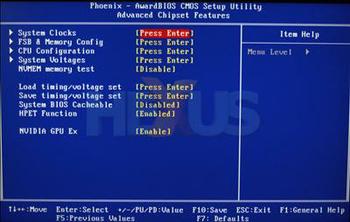BIOS thoughts
Jumping straight to the adjustments possible.
| Item | Adjustment |
|---|---|
| CPU bus frequency | 100 to 625MHz in 1-2MHz steps |
| CPU multiplier | 6x to 60x in 1x steps |
| DRAM frequency/multis | DDR2 400-1400MHz, increments vary |
| HT reference clock (SPP-MCP) | 200 to 500MHz in 2MHz steps |
| HT multiplier (MCP-SPP) | 1x to 5x in 1x steps |
| HT reference clock (MCP-SPP) | 1x to 5x in 1x steps |
| CPU voltage | 0.8V to 1.6V in 0.00625V steps |
| DRAM voltage | 1.800V to 2.5V in 0.1V steps |
| FSB termination voltage | 1.2 to 1.4V in 0.1V steps |
| PCI-Express frequency, slot 1 | 100MHz to 200MHz in 1MHz steps |
| PCI-Express frequency, slot 2 | 100MHz to 200MHz in 1MHz steps |
| NB voltage | 1.2 to 1.4V in 0.1V steps |
| Intel Speedstep Control/EIST | Yes |
Discussion
NVIDIA isn't selling the LT version of the 680i on its overclocking functions, as they did with its big brother. Instead it vaunts the "Great Overclocking" and says you can push the limits of the FSB. Hmm.Although it may not have all the extra technology that its big brother has, it still has the high-end underpinnings of the 680i SLI. All you're missing is the third PCIe graphics/physics slot, a surplus Ethernet connector, and a couple of USB ports, really.
Below are a number of photographs detailing some of the options present.









